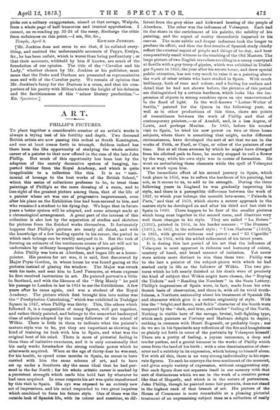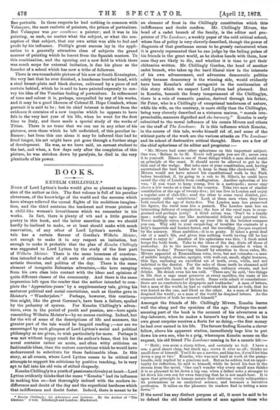ART.
PHILLIP'S PICTURES.
To place together a considerable number of an artist's works is always a trying test of his fertility and depth. Two deceased British artists are now passing this ordeal at South Kensington, and one at least comes forth in triumph. Seldom indeed has there been the like opportunity of studying the whole artistic .career of a painter to that now offered in the case of the late John Phillip. But much of this opportunity has been lost by the adoption of the merely decorative system of hanging, im- ported thither from the Royal Academy, and which is quite
inapplicable to a collection like this. It is no " testi- monial of homage to the best works of the British School," which this series of collections professes to be, to treat these paintings of Phillip's as the mere dressing of a room, and to 'lose sight of the greatest picture among them, that of the life of a painter whose art was one of progressive improvement, even after his place on the Exhibition line had been secured to him, and who remained a student to his dying day. We hope that in future years a better system will be adopted, and some attempt made at a chronological arrangement. A great part of the interest of this collection is also lost by the separation of studies and sketches for pictures from the finished works themselves. It fortunately happens that Phillip's pictures are nearly all dated, and with the knowledge of a few leading epochs in his career, the period to which each belongs can be readily assigned to it. But the task of forming an estimate of the continuous course of his art will not be undertaken by ordinary loungers through a picture gallery.
John Phillip was born at Aberdeen, and began life as a house- painter. His passion for art was, it is said, first discovered by Major Pryse Gordon, in whose house he was found gazing at the pictures instead of glazing the window. The Major was struck with his taste, and sent him to Lord Panmure, at whose expense be first received instruction in art. He painted portraits a little in Scotland, and with the likeness of the " Brig Manly " he paid his passage to London in her in 1834 to see the Exhibitions. A few years after he came again, and was a student of the Royal Academy. The picture which first brought him into notice was the " Presbyterian Catechising," which was exhibited in Trafalgar Square in 1817, when Phillip was thirty. This, like others which followed it, is a composition of many figures, well put together, and rather thinly painted, and belongs to the somewhat hackneyed -class of subjects adopted by the many followers of the school of Wilkie. There is little in them to indicate what the painter's mature style was to be, yet they are important as showing the kind of training he took with him to Spain, and what was the original bent of his mind. There is more of pictorial feeling in them than of imitative exactness, and it is only occasionally that his early works foreshadow the strong realistic power which he afterwards acquired. When at the age of thirty-four he was sent, for his health, to spend some months in Spain, he seems to have carried with him the same scheme of art, and to have set up under a Southern sky the same ideal that he had pur- sued in the far North ; for his whole artistic career is marked by a persistent strength which made him hold fast by whatever he had once acquired. In some respects his art was quite transformed by this visit to Spain. His eye was exposed to an entirely new set of impressions, and his mind responded to two great impulses which combined to form his future style. One of these was the outside look of Spanish life, with its colour and sunshine, so dif-
ferent from the grey skies and kirkward bearing of the people of Aberdeen. The other was the influence of Velasquez. Each had its due share in the enrichment of his palette, the solidity of his painting, and the aspect of reality thenceforth imparted to his canvas. The more subtle and deeper influence took the longer to produce its effect, and thus the first results of Spanish study chiefly reflect the external aspect of people and things of to-day, and bear comparatively small witness to the teaching of the Old Masters. The large picture of two English travellers revelling in a sunny courtyard at Seville with a gay troop of gipsies, which was exhibited in Trafal- gar Square in 1853, the year after his return home, and drew special public attention, has not very much to raise it as a painting above the work of other artists who have studied in Spain. With much brilliancy, both of tone and colour, and a feeling for surface and detail that he had not shown before, the pictures of this period are distinguished by a certain hardness, which looks like the im- pression of objects in strong sunshine upon an eye unaccustomed to the flood of light. In the well-known " Letter-Writer of Seville," painted for the Queen in the following year, as well as in other productions of this time, there are points of resemblance between the work of Phillip and that of contemporary painters,—as of Ansdell, and, in a less degree, of Lewis, and perhaps Maolise. In 1855, before his second visit to Spain, he tried his new power on two or three home subjects, where there is something that might, under different circumstances, have developed the sort of art that we see in the works of Frith, or Faed, or Cope, or other of the painters of our time. But at all these avenues by which he might have diverged from his allotted path to fame, he merely stopped to cull a flower by the way, while his own style was in course of formation. He went on assimilating these elements while the spell of Velasquez was at work upon him.
The immediate effect of his second journey to Spain, which took place in 1856, was to soften the hardness of his painting, but not, as it seems to us, to add to its strength. During the three following years in England he was gradually improving his style, and there is a perceptible difference between the work of 1857, to which year belongs the moonlit love-scene, " Palanda la Peva," and that of 1859, which shows a nearer approach to the mature style he developed on and after his third and last visit to Spain iu 1860. There happen to be four of the smaller pictures which hang near together in the second room, and illustrate very well these changes in his style. They are called " La Bolero" (1392), painted in 1854, in his harder manner ; " The Duenna " (1401), in 1857, in the softened style ; " livas Medusas " (1402), in 1861, with greater richness and power ; and " El Cigarillo " (1400), in 1864, with the added refinement of his latest years.
It is during this last period of his art that the influence of Velasquez is most apparent in richness and harmony of colour, mastery of hand, and broad manner of imitation. Yet never were artists more distinct in aim than these two. Phillip was to the last a painter of the subject-pieces with which he had started early in life as the follower of Wilkie. The two pic- tures which he left nearly finished at his death were of precisely the kind of subject that Wilkie might have chosen, the " Buying the Tickets" and " Reading the Numbers " in the State Lottery. Phillip's impressions of Spain were, in fact, made from his own Scotch basis of observation, and there is, with all its vivid truth- fulness, a Northern nationality about his treatment of Spanish life and character which give it a certain originality of style. With him the " bright,and fierce, and fickle" character of the South were tempered by the " dark, and true, and tender" feeling of the North. Nothing is visible here of the savage, brutal, bull-fighting type, which such painters as Fortuny and Madrazo delight to depict; nothing in common with Henri Regnault, or probably Goya ; nor do we see in his Spaniards any reflection of the fire and haughtiness so plainly set forth in some of the portraits by Velasquez himself; There are a purity of feeling, a joyous innocence, a deep and tender pathos, and a genial humour in the works of Philip which come from the land of his birth ; with a nice discrimination of char- acter and a subtlety in its expression, which belong to himself alone. Yet with all this, there is no very strong individuality in his sepa• rate figures. To each he conveys the true sentiment of the moment, and gives ample variety of expression, without exaggerating any. But each figure does not separate itself in our memory with that sort of distinctness which we see in the work of a creative power like that of Hogarth, and which is in the nature of portraiture. John Philip, though he painted some fair portraits, doesnot stand in the highest rank of that branch of art. His picture of the Howse of Commons is more remarkable as a pleasing pictorial treatment of an unpromising subject than as a collection of really
fine portraits. In these respects he had nothing in common with Velasquez, the most realistic of painters, the prince of portraiture. But Velasquez was par excellence a painter ; and it was in his painting, as such, no matter what the subject, or what the con- ception of that subject, that our own artist was able to feel and profit by his influence. Phillip's great success lay in the appli- cation to a generally attractive class of subjects the grand manner of painting which he learnt from the Spanish masters. To this combination, and the opening out a new field in which there was much scope for external imitation, is due his place as the founder of a school which has now a tribe of followers.
There is one remarkable picture of his now at South Kensington, the very last that he ever finished, a handsome bearded head, with a steel breast-plate and black sleeves, enlivened by a piece of red curtain behind, which he is said to have painted expressly to con- vey his idea of the Venetian feeling of portraiture. In refinement of tone and colour it is, perhaps, unequalled by any of his works, and it may be a good likeness of Colonel H. Hope Crealock, whose portrait it is said to be ; but its chief interest is derived from the evidence it contains of a new impulse which he appears to have felt in the very last year of his life, when he went for the first time to Italy, and there made a special study of the works of Titian. There is no trace that we can see in any other of his pictures, even those -which he left unfinished, of this peculiar in- fluence; but from this one alone it may be inferred that had he lived longer, his art might have yet gone through a further stage of development. He was, as we have said, an earnest student to the last, and when, a few days only after the completion of this picture, he was stricken down by paralysis, he died in the very plenitude of his power.



































 Previous page
Previous page